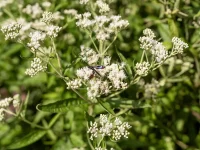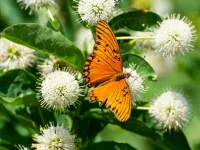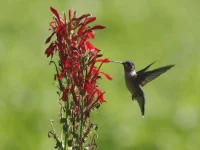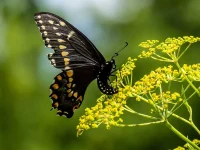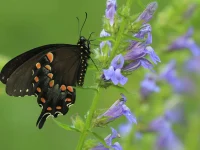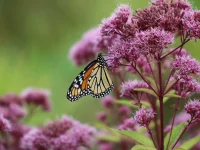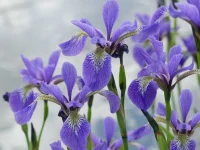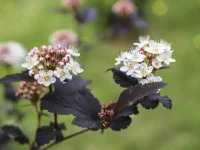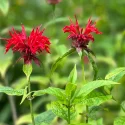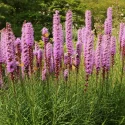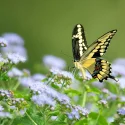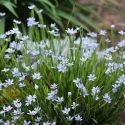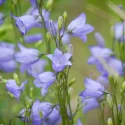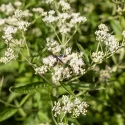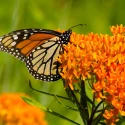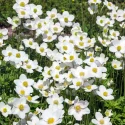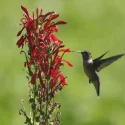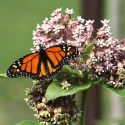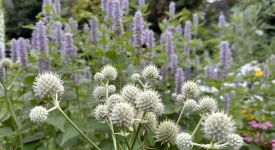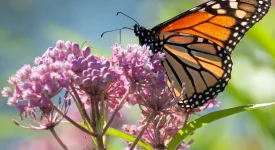Ironweed is a beautiful, tall native flower that helps ensure pollinators have something to eat in the late summer and fall. The strong, rigid stalks offer contrast against their delicate flowers. The tallness of ironweeds (2-10 feet) can be intimidating—but don’t be scared! Simply place these beauties in the center or back of your sunny garden, paired with shorter flowers and grasses. There are 25 species of ironweed native to North America. Scroll down to meet a few.
- Full Sun, Part Sun
- Height depends on species
- Summer flowers
- Pollinator lifeline
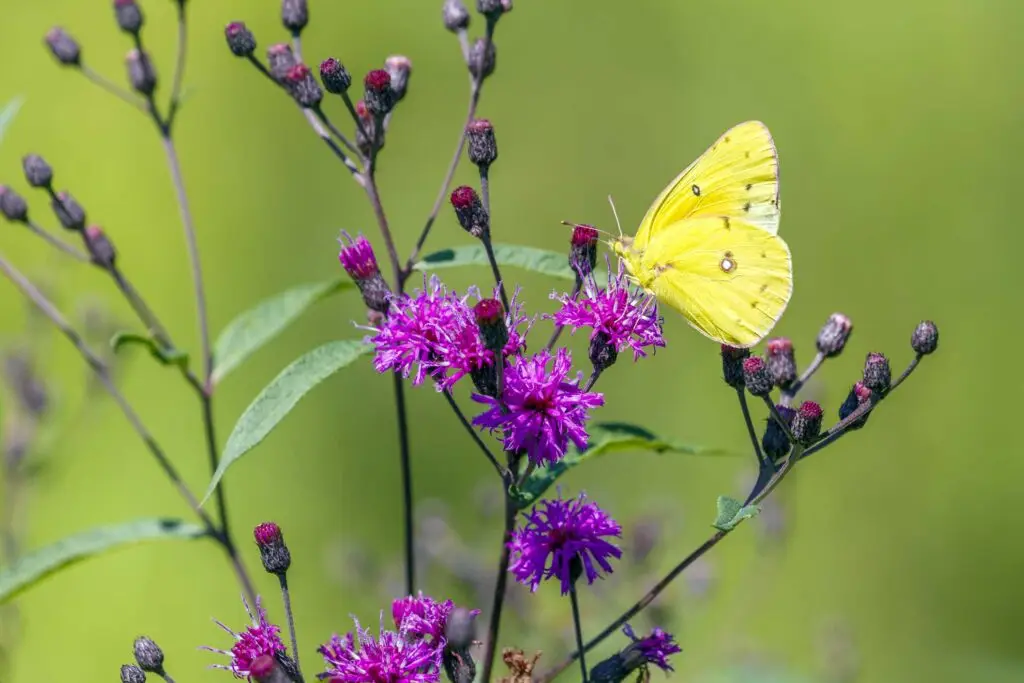
Dig Deeper
Explore the history, types, and where to plant native ironweeds
Table of Contents
Why is it important to plant native plants like ironweed?
Planting native plants makes our yards and spaces gorgeous while helping the birds, butterflies, and animals (and helping save us time!) Here are three reasons why planting native is worth it:
- Without native plants, iconic animals like Monarch butterflies and songbirds won’t have the food or homes needed to survive
- Native plants save time and money: after the first year of getting established, native plants like NY Ironweed are happy with rain
- Native plants are gorgeous! Ironweed is a perfect example of how beautiful and resilient native plants are—they are always the best choice for our gardens.
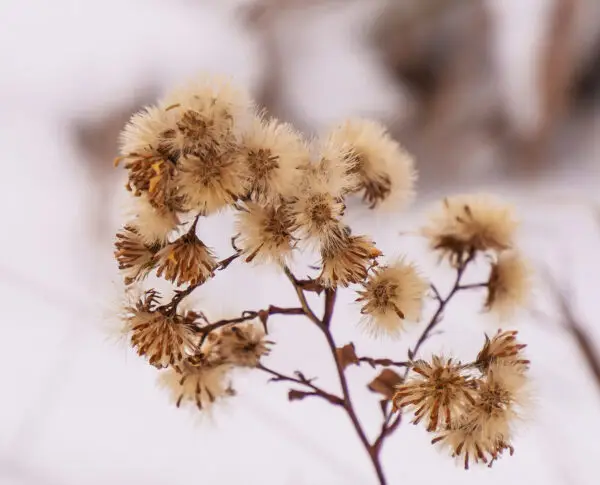
Where did the name ironweed come from?
The backstory of the name ‘ironweed’ is not so clear-cut. Some sources say it comes from the rigidity of ironweeds’ stems, while others say the name comes from the rust-colored hairs on ironweed seeds.
Yep. The name probably comes from these tiny, inconsequential details. Why are these statuesque purple flowers not called Amethyst Towers or Soaring Lilac?
While we don’t know exactly where the name came from, we know who to blame for missing the creative writing opportunity.
In North America, most common names were given by the early European colonists and settlers. These residents gave some stellar common names (American Beautyberry, Blazing Star, Goldenrod) and some terrible ones (tickseed, milkweed, spiderwort.) If you’d like to laugh at colonist copywriting, visit our Terrible Names, Beautiful Native Plants article.
Compared to ‘spiderwort,’ ironweed seems almost poetic.
Latin names are a big help
Latin names assist when you want to make sure you’re looking at the right plant. A plant has only one Latin name. Look for a Latin plant name starting with Vernonia to ensure you’re looking at ironweed.
Quick backstory on the Latin name Vernonia
Now that we brought up names, you might be asking: where did Vernonia come from? The Latin name honors British plant collector William Vernon, who visited Maryland just once in 1698 to collect plants before returning to England that same year. According to the British Bryological Society, “Nothing is known of his later years, or of when or where he died.”
Sadly, many beautiful North American native plants have Latin names drawn from disappointing (and always white, male) Europeans. Black-eyed Susans (Rudbeckia) and Magnolias have similar backstories.
Let’s put names aside for now. Time to meet some of these stunning native plants.
Native ironweeds
There are 25 species of ironweed native to North America. Here are a few species found at local plant nurseries (to date, Home Depot and Lowes have never carried this plant.)
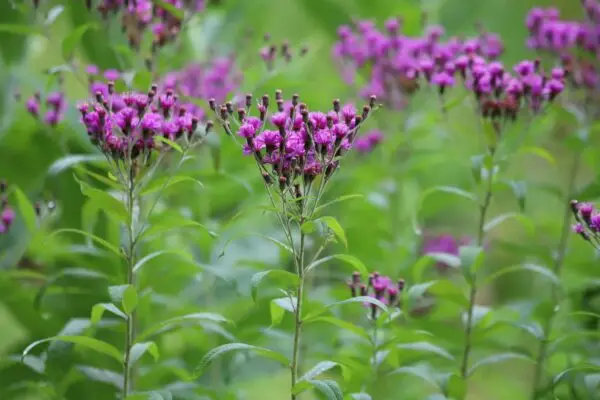
Curlytop or Arkansas Ironweed
Vernonia arkansana
Native to the Midwest and several states in the South. They are known for their rail-straight stalks paired with their wide-topped flowers.
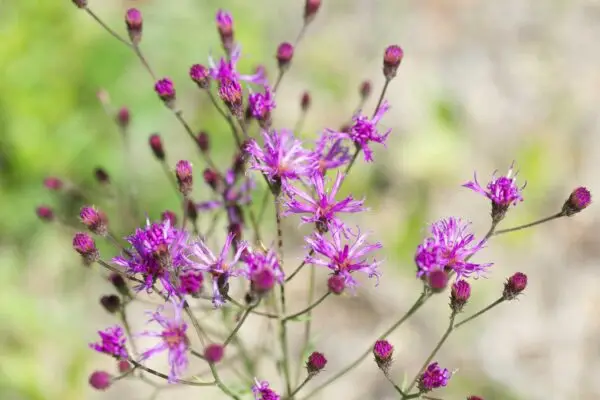
Giant Ironweed
Vernonia gigantea
As you can guess from the name—these get tall, topping out at 7′. Giant Ironweed is happy in a wide range of water conditions, from dry to wet. Flowers are more airy on thin stems.
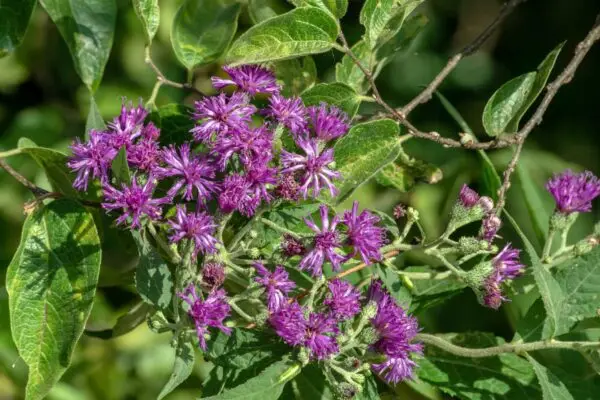
Missouri Ironweed
Vernonia missurica
It looks so similar to other ironweeds, but has even more flowers: up to 60 blooms on a single stalk.
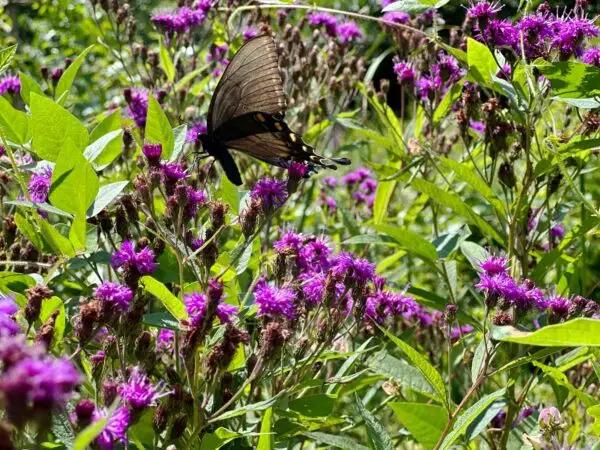
New York Ironweed
Vernonia noveboracensis
NY Ironweed can get tall—8′!. It prefers full sun and moist soil, like other ironweeds. It can bloom for a month or two at the end of the summer. A must for pollinator gardens!
Ironweed likes consistent water
Ironweeds are perfect for those sunny areas that consistently get water—in nature, they’re found on the sides of streams and lakes. You might have an area that’s low and collects water after rainfall. Or, perhaps you have an area that’s full sun where your drainspouts end. These are the types of areas where ironweed will thrive.
If you’re looking for native plants that can take full sun and consistent moisture, we recommend pairing Ironweed with native flowers like Joe Pye Weed, milkweed, and native asters.
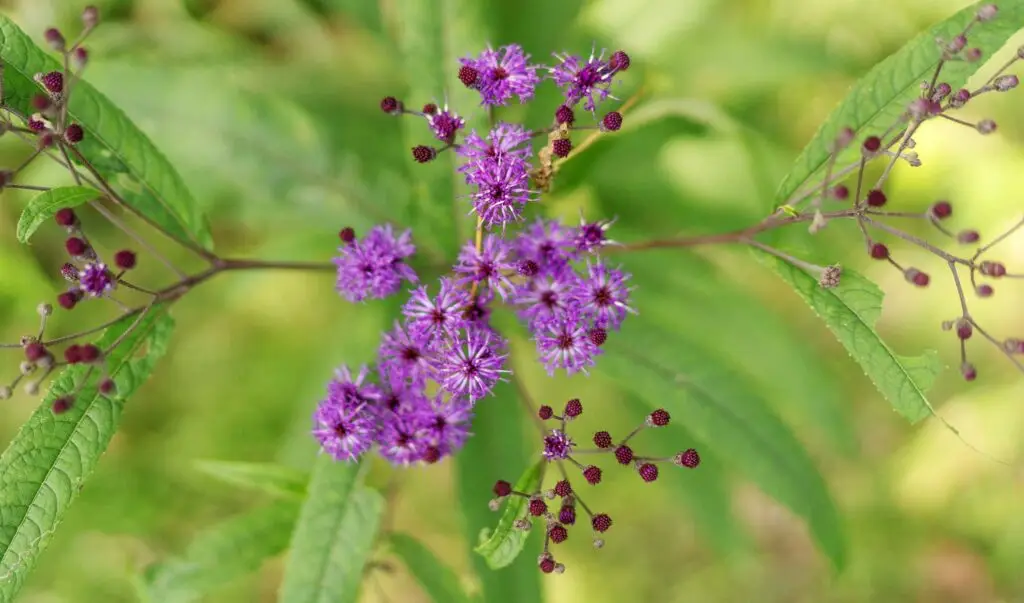
Where can I find ironweed plants for my garden?
The truth is that finding a specific native plant can sometimes be challenging. Most conventional nurseries only stock the most well-known native flowers (Black-Eyed Susans and Purple Coneflowers) and the rest is non-native.
But don’t give up! Here are four other options to help you find ironweed in your area:
Where can I find seeds and plants?
Finding native plants can be challenging (we partly blame Marie Antoinette.) To make it easier, we’ve assembled four sourcing ideas.
Native Nursery List
100+ native nurseries makes finding one a breeze
Online Native Plant Sellers
We've included 100+ online resources to help
Society Plant Sales
Every state has a native plant society; find yours
Online Communities
Local Facebook groups are a great plant source
What to plant with ironweed
Ironweed is a fantastic companion to other plants that like full sun and consistently wet conditions, like Buttonbush, Cardinal Flower, Swamp Milkweed, and Mountain Mint.
Ironweed is a perfect end-of-season bloomer for sunny, consistently wet gardens. Because they are perennials, you can plant them once and enjoy them for years. Their height makes them stunning flowering towers; give them a place to shine in your garden alongside shorter native plants. They are also great ideas for rain gardens—explore our Best Native Plants for Rain Gardens if you’d like more water-friendly inspiration. Or laugh at Terrible Names, Beautiful Native Plants. Happy planting!
Sources
- Nelson, Gil. Best Native Plants for Southern Gardens: A Handbook for Gardeners, Homeowners, and Professionals, (2010).
- Harstad, Carolyn. Go Native! Gardening with Native Plants and Wildflowers in the Lower Midwest. (1999), 209-210.
- Pyle, Robert Michael. Gardening for Butterflies: How You Can Attract and Protect Beautiful, Beneficial Insects. (2016), 121.
- Johnson, Terry. “Out My Backdoor: Ironweed, a Native Beauty.” Georgia Department of Natural Resources Division.
- Missouri Department of Conservation. “Ironweeds Field Guide.”
- Kulhanek, Ashley. “You Can Never Have Too Much IRONWEED! Part 1.,” Ohio State University, Buckeye Yard and Garden Online. August 15, 2023.
- Lobstein, Marion. “New York Ironweed (Vernonia Noveboracensis),” Prince William Wildflower Society. October 21, 2020.
- Wikipedia contributors. “Vernonia.” Wikipedia, August 3, 2024. https://en.wikipedia.org/wiki/Vernonia.
- “Vernon, William (C. 1666-1711) on JSTOR.” Plants.Jstor.Org.
- Lawley, Mark. William Vernon, British Bryological Society. (PDF).
